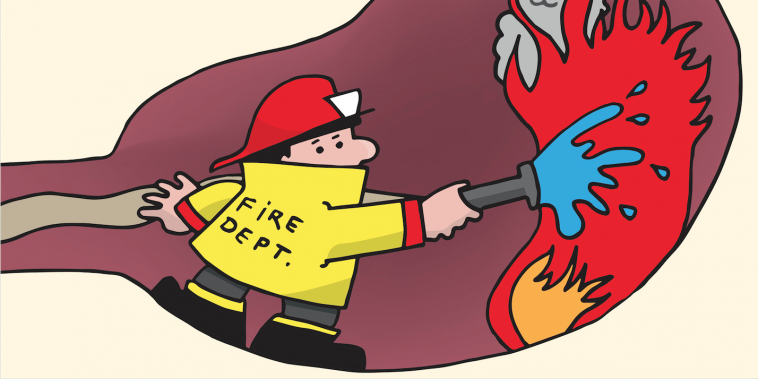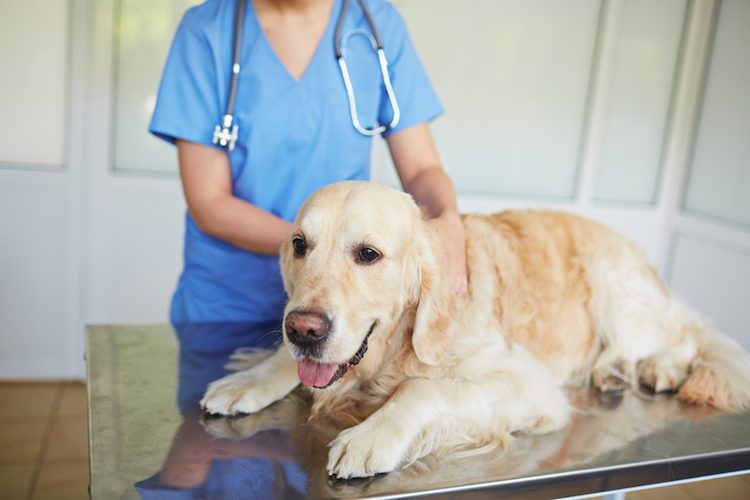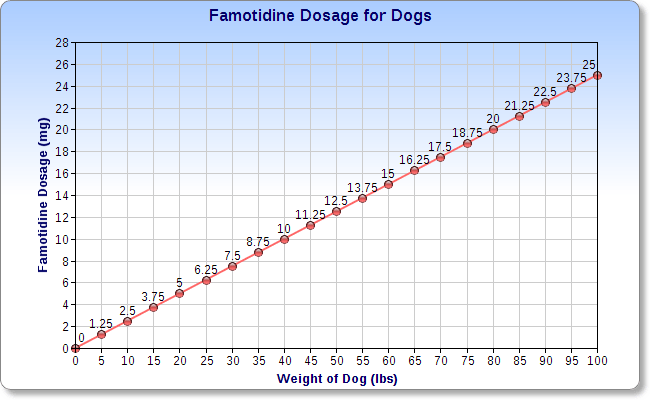What is Famotidine for dogs?
Thankfully, you came to the right place. We’re going to look at precisely what Famotidine is, how it works, what it’s prescribed for, and where you get it, among other things, to offer you a complete, comprehensive guide on the medication.
First of all, Famotidine is the generic name of the name brand drug Pepcid. Yup, that Pepcid that perhaps is already sitting in your medicine cabinet. It’s classified as a histamine-2 receptor that is used to treat ulcers in the digestive system, namely in the stomach.
It accomplishes this by reducing your stomach’s natural production of acids to lessen irritation. This means that not only can it work to treat ulcers, but it can also be used after they’ve already healed to prevent re-occurrence.
It requires a professional’s go ahead!
Due to its effectiveness in humans then, it should come as no surprise that many veterinarians have turned to prescribing it for dogs, as well. However, one thing that’s absolutely crucial to understand is that the FDA has never formally approved this medication for use in dogs and cats.
That means it’s still used on a case-by-case basis and should never be given without first speaking with your veterinarian following an in-depth examination as to the health of your pet, and some are more hesitant to recommend it than others.
Another must read: Best Dog Dewormers – For Dogs of All Shapes & Sizes
Why give dogs Famotidine?

Typically, the main reason for giving your dog Famotidine is because he or she is suffering from an ulcer. These occur when the hydrochloric acids in the stomach begin to tear through the gastrointestinal lining.
This can either be due to increased production of the acids that the protective layer of the stomach can’t fight off or due to a gradual fading of the layer entirely due to sickness or a reduction in food consumption.
Regardless of the reason why it happens, it’s quite uncomfortable for your dog, and Famotidine can help cut down on the production of acid to help the ulcers heal over time.
How does Famotidine help dogs?
That’s not the only thing that the medication is useful for, though. Most conditions that results from the production or use of gastric acids can be treated with this drug, though not all are serious enough to require its use.
For example, acid reflux (where the acids enter the esophagus) can result in GERD (or, gastroesophageal reflux disease) or esophagitis if not treated, both of which can go away on their own, but otherwise can cause some pretty potent damage if not treated.
Since all of these problems share the same root cause (i.e., acid), the application of the medication will generally significantly improve the quality of life of your pet. Their pain will lessen, the acid will subside which will avoid it from becoming a reoccurring problem, which in turn can prevent inflammations of the stomach from becoming ulcers over time. It’s a pretty sweet deal for your dog.
Where to buy Famotidine for dogs?
This is where it gets a little bit tricky. Pepcid/Famotidine is a medication for humans that has the same effects on us as it does on dogs. The significant difference is that if you want to grab a bottle to help with your acid reflux, you can just walk into your local pharmacy and pick one up.
Dogs can’t!
The use of the product on pets is restricted to a veterinary prescription. Now, the pills they’re likely going to give you come in the same sizes as their human equivalents. There will be more details below, but there’s no discernible difference.
Don’t medicate your dog out of your personal stash!
What’s vital for you to keep in mind is that you should never substitute your dog’s medication for your own, and you shouldn’t reach for a pill and give it to your dog if you suspect he or she has acid reflux but haven’t yet consulted with a professional.
There are some potential side effects and things your vet needs to know before he doles out a prescription, so be smart and do the right thing.
Things you should tell your veterinarian

Before reaching a diagnosis, your vet will most likely have to ask you some questions about any noticeable symptoms, which might include things like
- burping
- pained whining
- or lousy breath (trust us, you’ll know it when you smell it).
From that point, they’ll probably run an esophagoscopy, which uses a tiny little camera to inspect the stomach lining for breaks, wear and tear, and any potential bleeding.
Just remember that results don’t always necessitate a prescription, so it’s possible that you’ll be advised to just wait it out for a day or two to see how symptoms develop.
General things
Famotidine is generally not a very aggressive medication, and it tends to play nicely with other meds your dog might be on. There are a few pieces of information that you should have handy though. These things include any potential allergies to the drug since reactions have occurred in the past, as well as information on whether your dog is pregnant.
That won’t necessarily exclude her from taking the meds, but it can cause more significant fluctuations in her weight, which your vet may not be happy with. As always, a complete history of any heart, liver, and kidney disease is incredibly important to know, since these medications have effects that can interfere with the functioning of these critical organs.
Famotidine dosage in dogs

When it comes to other medications, there are very few hard and fast rules to follow. You should give your vet a complete list of what they’re taking for more personalized advice, but generally, you want to space out the dosing of other pills that they’re taking.
Giving too many drugs at the same time can be a little too heavy on the stomach, so giving other tablets a few hours before or after Famotidine makes it easier to process and reduces the risk of interference.
For convenience’s sake, these pills come in three different strengths:
- 10 mg
- 20 mg
- and a 40 mg pill, which is rarely prescribed.
The standard dosing recommendation (which, as always, may vary) is anywhere from .20 mg to .40 mg per pound of your pet.
That means a ten-pound dog might only need a 2 mg dose, which complicates matters somewhat when it comes time to break the pill into smaller chunks. Depending on the severity of the symptoms you could be instructed to give them the required dose every 12-24 hours.
For what period of time will my dog need it?
Length of use is entirely dependent on the severity of the ailment. Prescriptions for the drug come in packages of tablets that could last for an extremely long time if you’re the owner of a smaller dog. Therefore, it’s not as simple as using the meds until the prescription runs out.
Instead, you should give the medication consistently over the course of several days until their symptoms become less severe. Your vet will most likely tell you when this is likely to occur, so just keep a close eye on them until that point.
Once you think that they’re doing better, then to be safe, you can make a quick visit to the vet for the final word on whether or not you can safely discontinue usage.
How to dose with Famotidine
Since the pills come as tablets, the standard instructions apply here. Try to gently coax your dog into taking the medication, and if they refuse, then there are thankfully pill pocket treats and that glorious invention known as peanut butter to help your dog along the way.
In a worst-case scenario where your dog is refusing to take the meds entirely or if they’re having difficulties swallowing hard food, then there is an alternative. Famotidine is also available as a powder that can be administered orally, which makes it easier to apply, and for your dog to ingest which should make dosing a relatively stress-free process.
Give on an empty stomach
One key thing to note, though, is that this medication should be given on an empty stomach. Try to space it out between their meals, since eating can prompt the creation of more acid and enzymes. Since the meds are meant to reduce its production, the two work against one another, which could delay the healing process.
It’s quite difficult to make mistakes when giving your dog Famotidine, but it has happened before. To avoid this, set a timer daily and make sure only responsible members of the household have access to the drug.
Famotidine overdose in dogs
Ultimately the big question you’re looking to answer is if you’re at risk of unknowingly overdosing your dog.
The answer is yes!
If too much is given in too short of a time, it can prompt an overdose. Symptoms of this could include:
- heart palpitations (which is why your vet needs to know about the health of their heart)
- vomiting
- and collapsing.
Any of these could quickly become lethal if not treated correctly in a timely manner. If any of these symptoms occur, or if there’s any behavior that has you concerned, such as restlessness, skip their next dose of the meds and take them to the vet immediately. Again, it’s rare so don’t panic, but be careful.****
Famotidine side effects in dogs
As opposed to some other more potent drugs, you’ll be happy to know that Famotidine thankfully doesn’t come with a whole lot of baggage when it comes to the effects it has on your dog.
They’re relatively minor and include things like:
- loss of appetite
- fatigue
. . . but can also result in
- irregular bowel movements
- as well as changes to their consistency.
These are all normal and shouldn’t be any cause for alarm.
The major thing you need to be on the lookout for are any allergic reactions that might develop as a result of using the meds. If your pet has been given similar forms of medication in the past then they should theoretically be fine, but if not then you should be watching carefully for symptoms like:
- difficulty breathing (loss of breath or wheezing)
- excessive scratching due to rashes or general itchiness
- andor or swelling.
Contrary to the above, these should be cause for alarm and should prompt emergency care to both treat these symptoms and re-evaluate their medication to manage their existing ulcers as well.
Final say on giving dogs Famotidine

Acid reflux is a common problem in people today that can arise due to both diet and stress, and while it generally goes away on its own, it can develop into something more complicated over time.
Unfortunately, our loyal canine companions are also subject to the cruel medical condition that can:
- cause pain
- loss of appetite
- and even internal bleeding
. . . as the sensitive mucous lining of their stomach is slowly eroded away by overproduction of stomach acids.
Thankfully, Famotidine, or Pepcid, if your vet prefers the name brand equivalent, works to limit the production of these acids to alleviate pain, treat ulcers and prevent them from reoccurring.
While it’s not the most complicated drug in the world, there are quite a few things that you need to keep in mind when you first take them to the vet and are given that all-important prescription. Be sure to keep in contact your vet for more personalized instructions depending on the severity of your dog’s condition, and hopefully they’ll be fine in no time.
